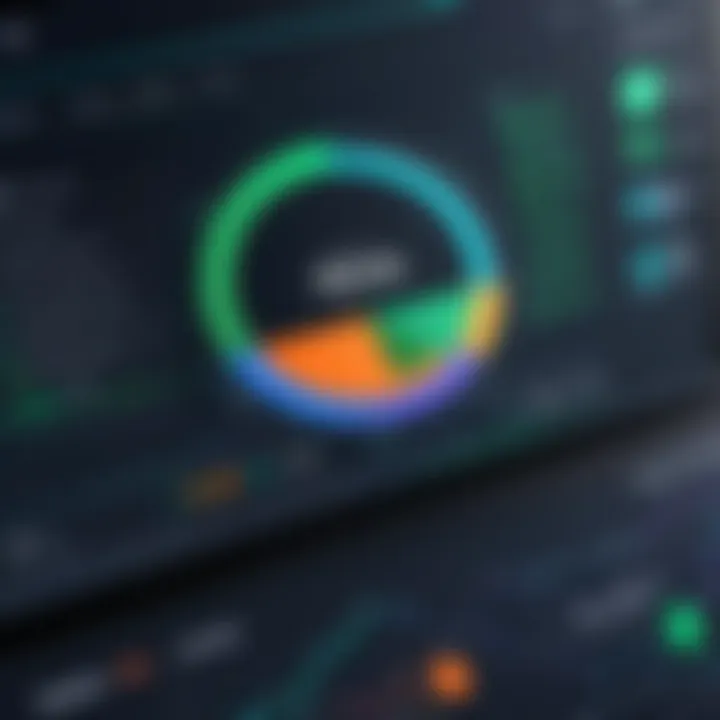In-Depth Review of Credit Analyst Software Solutions


Intro
In the realm of finance, assessing the creditworthiness of individuals and businesses stands as a cornerstone practice. As organizations strive to make well-informed decisions based on financial risk, the importance of robust credit analysis tools cannot be overstated. Credit analyst software has emerged as a critical asset, enabling financial institutions to streamline their processes and enhance accuracy.
This article will take a closer look at the various dimensions of credit analyst software, from core functionalities to the latest trends in the market. This journey will help uncover the value these tools bring to IT professionals, software developers, and businesses of all sizes. By the end, we hope to provide a comprehensive understanding of how these software solutions can reshape credit analysis.
Software Overview
Credit analyst software typically encompasses a range of functionalities designed to evaluate and monitor an entity's credit health effectively. Understanding these features offers insights into their value in real-world applications.
Features and functionalities
Modern credit analyst software is packed with features that cater to a variety of needs. Key functionalities include:
- Risk assessment: Tools to evaluate borrower risk based on various metrics.
- Credit scoring: Automated scoring systems that provide instant feedback.
- Reporting capabilities: Detailed reports that allow for deeper insights into credit data.
- Integration: Capacity to connect with existing financial databases and tools.
These features not only enhance efficiency but also bring a level of depth to the analysis that manual methods often miss.
Pricing and licensing options
When considering credit analyst software, pricing models can vary significantly. Common structures include subscription-based licenses, perpetual licenses, and pay-per-use options. Understanding total cost of ownership includes assessing:
- Initial setup fees
- Ongoing maintenance costs
- Potential costs for additional features
It's wise to evaluate what each pricing model offers, ensuring it aligns with organizational needs and budget constraints.
Supported platforms and compatibility
In today's diverse tech environment, compatibility is key. Most credit analyst software is designed to function across various platforms, including:
- Windows and MacOS: Desktop versions that are commonly used in finance.
- Cloud-based solutions: Accessible from any device with an internet connection, providing flexibility.
- Mobile applications: For on-the-go access and real-time updates.
This multifaceted support ensures that teams can work efficiently from different devices and locations.
User Experience
An intuitive user experience is vital when it comes to software adoption in the finance sector.
Ease of use and interface design
A clean and coherent interface is what every user seeks. Effective credit analyst software prioritizes user-friendliness by:
- Simple navigation: Clear pathways to essential functions.
- Visual tools: Interactive dashboards that present data at a glance.
- Onboarding processes: Aids new users in learning the software with ease.
Customizability and user settings
Each organization has unique requirements, making customizability a priority. Renowned software often allows:
- Personalized dashboards: Tailoring views to meet specific user needs.
- Custom report generation: Adaptable templates for various reporting standards.
Performance and speed
Time is money, especially in finance, which is why performance is paramount. Efficient software demonstrates:
- Fast load times: So users can access data without delays.
- Scalability: Ability to handle increasing amounts of data as businesses grow.
Pros and Cons
A balanced view of credit analyst software should weigh both strengths and weaknesses.
Strengths and advantages of the software
- Enhanced accuracy: Minimizing human error through automation.
- Comprehensive analysis: Access to a wide range of data for informed decisions.
- Time savings: Automation of routine tasks frees up analysts for deeper insights.
Drawbacks and limitations
Conversely, some issues may arise:
- Initial costs can be high for advanced solutions.
- Learning curve: Some systems may require significant training.
Comparison with similar products
When evaluating software, comparing similar products can clarify their value. For instance, tools like Moody's Analytics vs. Experian's business credit solutions may show:
- Different scoring algorithms and methods of data aggregation.
- Variations in integration capabilities with existing systems.
Real-world Applications
Navigating through specific industries reveals how credit analyst software shapes business outcomes.
Industry-specific uses
For example, in banking, software enables:
- Loan approval processes: Streamlining applications based on pre-established criteria.
- Portfolio management: Continuous tracking of credit levels across multiple clients.
Case studies and success stories
Researching credible examples illustrates the success of software implementations. For instance, a regional bank reported enhanced loan processing times by over 30% after adopting a particular suite of tools.
How the software solves specific problems
Identifying problems is easier when software can clearly address them. Tools like SAS Credit Scoring and FICO Score focus on improving the accuracy of predictions, thus reducing costs associated with defaults and late payments.
Updates and Support
A software product's longevity is often linked to its support and updates.
Frequency of software updates
Regular updates not only ensure the software is secure but also enhance functionality. Many providers schedule:
- Quarterly updates: For significant upgrades and new features.
- Monthly patches: For addressing security vulnerabilities and minor issues.


Customer support options
Robust customer support is a critical component of software reliability. Effective options include:
- 24/7 help desks: For instant resolutions to urgent queries.
- Live chat and email support: For detailed inquiries.
Community forums and user resources
A vibrant community can enhance user experience significantly:
- Users sharing solutions in forums can provide insights that official support might miss.
- Educational resources and workshops help users maximize the software’s potential.
Prelims to Credit Analyst Software
In today's fast-paced financial environment, the role of credit analyst software cannot be overstated. These tools are not merely helpful; they are essential for any financial institution looking to assess creditworthiness effectively. With the increasing amount of data available, the ability to analyze this information has transformed the way decisions are made. The introduction of sophisticated credit analysis tools is pivotal in navigating this data-driven landscape, making it imperative for professionals in the finance sector to understand their functionalities and applications.
Definition and Purpose
Credit analyst software is designed to facilitate the detailed assessment of the credit history and financial stability of individuals or entities. At its core, the primary purpose of this software is to provide a robust analytical framework that helps decision-makers evaluate risk. This software typically includes tools for data aggregation, analysis, and reporting, enabling users to quickly synthesize large volumes of information.
In practical terms, think of credit analyst software as the compass in a financial analyst’s toolkit. Whether it’s for evaluating loan applications, assessing investment risks, or conducting portfolio analyses, these solutions are tailored to enhance efficiency and accuracy. The use of these tools allows financial professionals to make well-informed decisions, minimizing potential risks that come from poor assessments.
Historical Context
The evolution of credit analysis software reflects broader changes in the financial industry. Initially, credit analysis relied heavily on manual processes, which often led to slower decision-making and inconsistencies in evaluations. Armed with only a calculator and an extensive knowledge of financial ratios, analysts had to sift through reams of paperwork to derive insights.
It wasn’t long before technological advancements began to take shape. The late 20th century saw the emergence of personal computing, making it feasible to handle data more effectively. As databases grew and software capabilities expanded, systems like FICO models came into play, allowing for standardized scoring methods that could be applied across various loan types directly.
In the 21st century, challenges such as regulatory changes and a rapidly evolving economic landscape have pushed credit analysis into even more complex territories. Software has adapted accordingly, incorporating features that address compliance concerns and enhance predictive capabilities. The modern tools of today not only improve accuracy in credit assessments but also empower analysts with the flexibility to make data-driven decisions, thus transforming the role of the credit analyst into a more strategic function within financial institutions.
"Understanding the progression of credit analysis tools allows today’s professionals to harness the full potential of these resources in a way that aligns with both current market demands and regulatory guidelines."
By acknowledging the historical background and evolution of these tools, users can appreciate the sophisticated nature of modern credit analyst software and its profound impact on financial decision-making.
Importance of Credit Analysis
Credit analysis is a critical aspect of financial operations, serving as the backbone for evaluating the creditworthiness of individuals and organizations. In today’s fast-paced economic environment, making informed lending and investment decisions directly hinges on the insights gained from effective credit analysis. It not only helps financial institutions minimize risk but also plays a vital role in fostering economic growth by ensuring that lending goes to borrowers with reliable repayment capabilities.
Role in Financial Decision-Making
Credit analysis significantly influences financial decision-making by evaluating how likely a borrower is to repay a loan. This process often incorporates several factors, including credit history, income levels, and evidence of previous financial behavior.
- Credit History Assessment: This evaluates past borrowing and repayment patterns. For example, if a small business has a history of timely payments, creditors may be more inclined to offer favorable terms.
- Debt-to-Income Ratio: The calculation of how much debt a borrower carries in comparison to their income provides lenders with insights on the borrower’s ability to manage additional debt. A lower ratio typically signals that a borrower can comfortably handle new loans.
- Market Conditions: Analysts often look at broader economic indicators that could affect repayment ability. For instance, during an economic downturn, even reliable borrowers might struggle.
By carefully analyzing these factors, institutions can make sounder credit decisions that mitigate risk and promote financial stability. This process not only safeguards the lender’s interests but also supports borrowers in navigating their financial journeys responsibly.
Impact on Risk Management
The importance of credit analysis extends beyond just individual lending decisions; it plays a crucial role in the broader domain of risk management within financial institutions. By implementing robust credit analysis practices, organizations can better manage various risks associated with lending.
- Identifying Potential Defaults: By analyzing credit data, firms can identify lending risks early on, allowing them to take preemptive measures. For example, if a borrower shows declining income trends, lenders may choose to adjust terms or reconsider the loan altogether.
- Portfolio Diversification: Understanding the credit risk of various borrowers helps institutions diversify their portfolios effectively. This spreads risk across different sectors, reducing the impact if one sector faces distress.
- Regulatory Compliance: Regulatory bodies often require that financial institutions assess credit risk meticulously. This not only protects the institution but also fortifies the whole financial system.
In summary, the significance of credit analysis encompasses enhancing financial decision-making and strengthening risk management practices. It equips lenders with the necessary tools and insights to navigate the complexities of credit worthiness, fostering a resilient financial environment.
"Without insightful credit analysis, institutions risk becoming blind to the challenges posed by an unstable economy."
Establishing effective credit analysis protocols is essential for financial institutions aiming to thrive while minimizing risk and ensuring fair lending practices.
Key Features of Credit Analyst Software
The realm of credit analysis has always been marked by the need for precision and reliability. As such, when we discuss the key features of credit analyst software, we aren't merely tossing around buzzwords; we are identifying critical functions that ensure accuracy in credit assessments. This software serves as a backbone for financial institutions, allowing them to sift through mountains of data and extract actionable insights. Thus, understanding these features isn't just an exercise in curiosity. It's fundamental for financial professionals aiming to refine their strategies and enhance their decision-making processes.
Data Collection and Analysis
Data collection stands as the cornerstone of effective credit analysis. In this digital age, having access to high-quality data is paramount. The software integrates various data sources to compile a comprehensive view of a potential borrower’s creditworthiness. These sources can range from traditional financial statements to alternative data like payment histories and social behavior patterns.
A well-designed system will not only automate data gathering but also include data cleansing features. This is critical; one wouldn’t want to base decisions on flawed or outdated information. Additionally, the analysis tools within this software aid users in dissecting trends from historical data, enabling them to spot patterns that could indicate risk.
"In the world of credit analysis, data is as important as the decisions made from it."
Predictive Analytics
Predictive analytics has revolutionized the credit analyst role. Rather than relying solely on past performance, this feature leverages statistical algorithms to forecast future behavior. By using techniques such as regression models and machine learning algorithms, it provides critical insights into how likely an applicant is to default on a loan.
Financial institutions can customize these predictive models to align with their risk appetite and market conditions. This means they can set parameters that are specific to their lending criteria, effectively tailoring their assessment processes. The beauty of predictive analytics is not just in risk assessment but also in its ability to refine lending strategies, leading to more informed decisions. In turn, this enhances profitability while mitigating risk exposure.
Reporting Tools
Robust reporting tools encapsulate the data and analytics into easily digestible formats, making them invaluable for stakeholders at all levels. These tools convert raw data into visual narratives that convey complex information rapidly.
Whether it’s generating interactive dashboards, detailed analytical reports, or concise summaries, effective reporting features ensure that critical insights don’t get lost in translation. Additionally, customizable reporting allows users to focus on specific metrics that matter most to their operations.
As we approach increasingly stringent regulatory environments, the ability to easily generate compliance reports through these tools has become non-negotiable. It not only ensures regulatory adherence but also helps in audit readiness, leading to enhanced transparency within organizations.
In summation, the features of credit analyst software serve as both tools and shields for financial institutions. They not only streamline the process of credit assessment but also arm users with the knowledge needed to make well-informed lending decisions.
Types of Credit Analyst Software
Understanding the Types of Credit Analyst Software is central to making informed decisions about which tools best fit the requirements of businesses when it comes to credit analysis. The landscape of financial technology presents a variety of software solutions that cater to different organizational needs, and knowing the differences between these options is crucial. Each type of software offers unique features, benefits, and considerations that influence how creditworthiness is assessed and managed in a competitive environment.
In essence, sorting software into categories such as standalone solutions and integrated systems enables users to pinpoint which tool aligns with their operational architecture, strategic goals, and budgetary constraints. It’s not a one-size-fits-all scenario, so understanding the nuances between these options becomes paramount. Let’s dissect these types further.
Standalone Solutions
Standalone credit analyst software operates independently from other business applications. This type of system is built to provide focused functionalities for credit assessment, often with specialized tools for data analysis and reporting. Here are some significant aspects:
- Ease of Use: Typically, these solutions are designed with a user-friendly interface, ensuring users can quickly adapt and make sense of the software without extensive training.
- Cost-Effective: For smaller organizations or startups, standalone systems could prove economically sensible since they do not require investment in comprehensive integrations with existing software.
- Customization: Many standalone products allow for a considerable degree of customization, enabling businesses to tweak the tool according to their specific credit analysis needs.
- Focused Applications: Such software often focuses heavily on credit reports, risk analysis, and providing immediate insights, which can be beneficial for firms requiring fast decision-making.
However, there’s a flip side. Standalone solutions might lack deeper functionalities, such as cross-functional data sharing, which can limit their effectiveness in a broader enterprise context.
Integrated Systems
Integrated systems, on the other hand, are designed to work within a suite of business applications or as part of a larger software ecosystem. These tools facilitate seamless data exchange between different departments and modules. Some key features to consider include:
- Holistic Data Management: Integrated systems thrive on the synergy of various applications, allowing for better data management and utilization across departments like finance, marketing, and operations.
- Enhanced Collaboration: The collaborative features enable departments to work hand in hand, reducing silos and fostering a more cohesive approach to credit risk assessment.
- Scalability: Such systems can grow alongside the business, making it easier to add features or access additional services as the organization expands or evolves.
- Data Accuracy and Tracking: With interconnected applications, data accuracy is enhanced since multiple users can input and monitor data in real-time, leading to more reliable outcomes.


Yet, integrated systems can come with their own set of challenges. They might present a steeper initial learning curve and require larger upfront investments.
Overall, each type of credit analyst software carries distinct advantages and limitations. Making an astute choice between standalone solutions and integrated systems revolves around understanding your organization's specific needs, infrastructure, and long-term goals. In a rapidly evolving financial landscape, this decision is not just a financial one; it can significantly impact operational efficiency and credit decision-making processes.
Evaluating Software Options
Evaluating software options plays a pivotal role in the credit analysis landscape. As businesses strive to maintain financial health and mitigate risk, the tools they choose can significantly affect their success. It’s not just about selecting any platform; it involves a careful, methodical approach to choose the right software that aligns with an organization’s unique needs. In doing so, decision-makers can ensure enhanced accuracy in credit evaluations, reduce operational costs, and meet compliance requirements more effectively.
One essential element in this evaluation process is understanding the specific requirements of the organization. Different financial institutions have varied needs based on their clientele, market focus, and risk appetite. As a result, one software may shine in some aspects but fall short in others. Therefore, rigorous assessment against set benchmarks enables firms to pinpoint solutions that will optimize their workflow while maintaining a user-friendly experience.
Key benefits of thorough evaluation include making informed decisions based on data rather than instincts, fostering accountability in the selection process, and ensuring that the investment aligns with both current and future goals. Besides, understanding the implications of different software options may lead to discovering features that one didn’t know were essential, thereby pushing the organization ahead in the competitive landscape.
Critical Evaluation Criteria
When delving into the critical evaluation criteria for assessing credit analyst software, several key aspects come into play. Understanding these fundamental factors is paramount for making an informed selection:
- Functionality: Does the software fulfill the core functions required for credit analysis? Look for solutions that support essential tasks like data collection, risk assessment, and compliance tracking.
- User Interface: A clean, intuitive interface can drastically improve efficiency. If users struggle to navigate the software, it can lead to mistakes and frustration.
- Integration: Consider how well the software can integrate with other platforms and systems already in use. Seamless integration can facilitate the sharing of data and reduce redundancy.
- Scalability: As businesses evolve, their software requirements may change. Ensuring that the software can scale according to business growth is vital.
- Support and Training: Evaluate the quality of customer support and training offered. Comprehensive training can help users maximize software capabilities, while responsive support is crucial for resolving issues swiftly.
In essence, taking a comprehensive approach to evaluate according to these criteria aids businesses in avoiding pitfalls that often accompany hasty decisions.
Cost Considerations
Cost considerations are likewise a cornerstone of any evaluation process. However, it’s not merely about the upfront cost but encompasses the total cost of ownership. This includes subscription fees, maintenance costs, training expenses, and any other hidden charges that may arise post-implementation.
- Initial Investment: Assess whether the software comes with a one-time purchase cost or a recurring subscription model. Looking into expected returns on investment can help mitigate financial risks.
- Maintenance Costs: Is there a dedicated team needed for maintenance? Software that requires constant updates not only contributes to ongoing costs but also could lead to potential downtimes.
- Training Expenses: Understand whether training is included in the price. Additional costs for training can stack up, particularly for large teams that require extensive onboarding.
- Opportunity Costs: Consider what the organization may lose if the software doesn't meet expectations. This can manifest in lost revenue opportunities, inefficient processes, or even reputational damage.
When businesses engage with these financial aspects of software evaluation, they empower themselves to make choices that are sound and strategically aligned with their fiscal objectives.
User Experience and Usability
A well-crafted software isn't just about powerful algorithms and expansive databases—it's also about how users interact with that software. In credit analysis, where speed and accuracy are paramount, the user experience (UX) and usability of the software can make or break the decision-making process. It may sound trite, but if the tools aren't easy to use, it can lead to misjudgments that have real-world financial implications.
Good user experience and usability ensure that the software caters to the immediate needs of the analysts, allowing them to navigate through vast amounts of data without feeling like they’re trying to find a needle in a haystack.
Benefits of Prioritizing User Experience
- Faster Training: A clean, intuitive interface minimizes the training time required for new users. They can jump right into analyzing credit data without feeling overwhelmed.
- Higher Efficiency: Users can save time in their workflows. This efficiency means that financial institutions can process more applications quickly, which can lead to higher profitability.
- Reduced Errors: Simplifying the design reduces the risk of user errors. If analysts can quickly locate and process relevant data, they’ll make more informed decisions.
The importance of continuous user feedback also can’t be stressed enough. This feedback helps evolve the tool, ensuring it aligns with the ever-changing needs of its users. Without this iterative improvement, software can become outdated or irrelevant.
Interface Design
The interface design is the first point of contact for users, acting like the storefront of a retail business. A slick design attracts users, while functionality keeps them coming back. A user-centric approach to interface design involves understanding not just what looks good, but what truly serves the user. This could include:
- Clear Navigation: Users should easily locate key features without a navigation manual. Drop-down menus and search functions reduce unnecessary clicks.
- Visual Aids: Charts, graphs, and dashboards can help simplify complex data. If analysts can visually interpret a slew of numbers easily, they’re more likely to spot trends and make decisions.
- Mobile Responsiveness: With mobile devices being a staple in today’s work environment, ensuring your software is usable on various devices is essential.
Design is not just about aesthetics; it’s about creating an environment where users feel empowered to work effectively.
Training and Support
Even with the best interface design, the path to proficiency can still be rocky without adequate training and support. Having a user manual or tutorial videos is like handing a compass to someone lost in the woods. It gives direction and builds confidence.
- Tailored Training Programs: Every organization is unique. Training sessions tailored to the specific needs of the staff can bridge the knowledge gap effectively.
- Access to Resources: Users benefit from readily available resources like FAQs, community forums, and educational webinars. People learn at different speeds and having these resources available can eliminate frustration.
- Effective Customer Support: Quick access to tech support can alleviate many issues. Whether it’s through live chat, email, or phone, having a dependable support system can turn a potentially exasperating experience into a seamless one.
"The key to successful software is enabling users to spend more time on analysis rather than deciphering how to use the software itself.”
Key Players in the Credit Analyst Software Market
When diving into the ever-evolving landscape of credit analyst software, it becomes clear that the market is not a simple one. It hosts a blend of established brands and emerging players, each bringing advances that shape how credit analysis is approached today. The presence of diverse players fosters innovation and significant competition, leading to better products and solutions for end-users.
This section emphasizes the importance of understanding these key players. With a proliferation of software options, businesses must sift through offerings and discern which tools align best with their specific needs. Recognizing the strengths and weaknesses of leading brands and newer solutions becomes vital for informed decision-making.
Established Brands
Established brands in the credit analyst software market are those who have stood the test of time and proven their capabilities in factoring risk and creditworthiness with precision. Often, they lead with strong reputations built through reliability, comprehensive functionality, and robust customer support.
Attributes of Established Brands
- Reputation and Experience: These brands often have decades of experience in finance and technology, positioning them as trusted partners.
- Comprehensive Solutions: They typically provide a full suite of features, such as predictive analytics, detailed reporting, and strong data security measures.
- Support and Training: Many established firms offer extensive support services, including training for new users, ongoing customer support, and frequent updates based on user feedback.
Some prominent players in this field include:
- Moody's Analytics: Often recognized for its depth in risk analysis and credit data.
- S&P Global: Known for its detailed reports and analytics tools aimed at various sectors.
- FICO: Specializes in analytics and decision management, helping businesses in credit decisions and fraud protection.
“Reputations are built on years of experience, and established brands tend to offer a sense of security that newer companies cannot yet provide.”
It's the established brands that often set the tone for trends in the software market, leading innovations that smaller firms may later adopt with adaptations.
Emerging Solutions
Alongside the established players, the rise of emerging solutions signifies a shift in the market dynamics. These newer companies tend to be agile and often harness cutting-edge technologies to provide unique offerings that challenge traditional methods of credit analysis.
Characteristics of Emerging Solutions
- Innovation and Agility: Startups and newer entities often push the envelope by integrating the latest tech, like artificial intelligence or blockchain, into their platforms.
- User-Friendly Interfaces: Emerging solutions prioritize usability, often catering to companies that may not have dedicated finance teams.
- Cost-Effective Alternatives: New businesses often appear as budget-friendly as they seek to attract clients away from established offerings.
Some noteworthy emerging players include:
- Zest AI: They focus on machine learning algorithms to better assess credit worthiness and eliminate traditional biases.
- Upstart: Aiming to revolutionize personal loans through AI-based credit scoring.
- Lenddo: Utilizing social data to assess creditworthiness, particularly in developing markets.
These newcomers can disrupt the market by delivering solutions that are faster, simpler, and often more intuitive than their predecessors, encouraging the incumbents to innovate further. Understanding these players helps professionals in finance make strategic choices that suit their organizational needs.
As the field of credit analyst software continues to grow, recognizing and analyzing both established brands and emerging solutions is essential for anyone involved in financial decision-making. The ongoing competition enhances overall quality and diversity of available technologies, ensuring that each organization can find software that fits its specific requirements.
Technological Advancements
Technological advancements play a pivotal role in shaping the landscape of credit analyst software. Innovations, particularly in artificial intelligence and machine learning, have ushered in a new era of efficiency and accuracy in credit analysis. As these tools keep evolving, understanding their benefits and implications is crucial for financial institutions looking to enhance their decision-making capabilities.
Artificial Intelligence Integration
The integration of artificial intelligence (AI) in credit analyst software is not just a luxury but a necessity in today’s fast-paced financial environment. AI algorithms can process massive quantities of data at a speed and precision that is practically impossible for humans. This capability allows analysts to generate insights based on historical data, market trends, and individual credit behaviors in real-time.
AI’s predictive modeling capabilities help in forecasting risk profiles. By utilizing intricate models, AI can help institutions assess potential defaults more accurately. For example, tools like Zest Finance or Upstart use AI to analyze non-traditional data, such as social media activity and online behavior, to provide a more comprehensive view of an applicant's creditworthiness.
Moreover, AI systems continue to learn from fresh data inputs over time, improving their accuracy and effectiveness in credit decision-making. Consequently, businesses can significantly reduce the time spent analyzing applications, allowing them to focus on other strategic initiatives.


"Incorporating AI into credit analysis processes not only bolsters efficiency but also enhances risk evaluation accuracy, reshaping the credit landscape."
Machine Learning Applications
Machine learning (ML), a subset of AI, stands as a game changer in credit analysis software. It allows tools to learn from previous data patterns and adapt to new information autonomously. This is vastly beneficial as the financial landscape and consumer behaviors are constantly changing.
For instance, credit scoring models—once purely statistical—now leverage machine learning to uncover hidden relationships within large datasets. Companies like FICO have begun integrating machine learning algorithms into their credit scoring models to improve their accuracy. It means, as new credit data gets fed into the system, the scoring model can adjust and provide more relevant assessments.
Additionally, ML can help in detecting fraudulent activities more effectively. By analyzing user behaviors and transactions, machine learning can identify anomalies that deviate from established patterns, flagging potential fraud attempts swiftly. This not only protects financial institutions but also lends credibility to their credit assessments, fostering more honest relationships with customers.
Challenges in Credit Analysis
The landscape of credit analysis is riddled with various challenges that professionals face in their daily operations. Acknowledging these obstacles is vital in the context of this article, as overcoming them can significantly enhance the decision-making processes within financial institutions. From safeguarding client information to adhering to rigorous standards, these challenges shape how credit analysts navigate their responsibilities.
Data Privacy Concerns
In an age where data is often labeled as the new oil, the importance of data privacy cannot be overstated. Credit analysts extensively handle sensitive customer and financial data, raising considerable concerns about how this information is stored, shared, and protected.
On the one hand, there’s a pressing need for analytical precision that often requires access to personal information. On the other hand, using that data irresponsibly can lead to breaches, eroding trust from both customers and regulators. This precarious balancing act necessitates implementing robust data protection measures, ensuring adherence to laws like the General Data Protection Regulation (GDPR) in Europe and similar frameworks globally.
Moreover, financial institutions must routinely conduct audits and risk assessments to identify any vulnerability in their data handling practices. If this isn't done, the repercussions can be dire, including hefty fines and irreparable damage to brand reputation. Thus, strategies for safeguarding data, such as pseudonymization and encryption, emerge as critical components in defending against potential breaches.
Compliance Issues
Compliance in credit analysis serves as the backbone of a trustworthy financial operation. Regulatory bodies set complex guidelines that demand meticulous adherence, and failure to comply can lead to severe penalties, not to mention damage to a company’s credibility. Laws and regulations, including the Fair Credit Reporting Act (FCRA) and anti-money laundering (AML) laws, are examples of frameworks guiding credit analysts in their practices.
Financial institutions often find themselves tangled in red tape, making it difficult to keep up with the evolving regulatory landscape. This complexity can result in missed deadlines for reports or mismanagement of client data—all of which can spark investigations and legal ramifications. To tackle these issues, many organizations are investing in compliance management software that monitors changes and ensures timely submission of necessary documentation.
Furthermore, training staff on compliance matters is also crucial. Regular sessions can help keep everyone on the same page about new regulations, adjusting processes as needed to avoid pitfalls.
"Understanding the intricacies of compliance isn't just about dodging fines; it's about fostering an environment of trust for clients and regulators alike."
Future Trends in Credit Analysis Software
The credit analysis landscape is ever-evolving as businesses look towards innovative solutions to enhance decision-making processes. Trends in credit analysis software reflect not only advancements in technology but also changing needs of financial institutions, regulators, and consumers. This section explores two major trends—cloud-based solutions and user-centric development—providing insights into their significance and impact.
Cloud-Based Solutions
Cloud technology has changed the game for credit analyst software. By allowing data storage and processing over the internet, businesses can now access their tools and data on-the-go. This flexibility presents numerous benefits. For instance, compliance with regulations becomes much easier when all information is centralized and updated continuously.
In addition, cloud-based solutions often come at a lower cost compared to traditional systems. Smaller firms, which might have tight budgets, benefit immensely from lower maintenance costs and quicker implementation times.
With software vendors like Oracle and SAS offering robust cloud functionality, users enjoy improved scalability. This means as a business grows, its software can upscale seamlessly, adapting to increased data volume or user demands without substantial hardware investments.
Some key advantages of cloud services include:
- Accessibility: Users can access tools from anywhere with internet, promoting remote work.
- Regular Updates: Software undergoes continuous improvement without the need for disruptive upgrades.
- Cost-Effectiveness: Reduced need for extensive IT infrastructure cuts down on upfront investment.
However, organizations must still consider data privacy concerns when storing sensitive credit information in the cloud. Establishing best practices for security is crucial.
User-Centric Development
As demands evolve, the need for user-friendly interfaces in credit analyst software grows increasingly clear. Software developers are starting to prioritize user experience, emphasizing intuitive design. This doesn't just mean a shiny homepage—it's about creating a workflow that caters to the day-to-day needs of the user.
By investing in user-centric development, companies like FICO and Experian are ensuring that their tools do not just function well, but also empower users to make quick decisions. With streamlined processes and clear visualizations, users spend less time navigating the software and more time analyzing data. Apart from that, providing training and support ensures users can adapt swiftly to any updates or new features.
Some elements of user-centric design include:
- Customization Options: Allowing users to tailor features according to their workflow.
- Visual Analytics: Employing charts and graphs for clearer data interpretation.
- Interactive Dashboards: Engaging layouts keep users informed at a glance.
Incorporating user feedback into the development process results in software that actually meets its intended goals. > User engagement during development can drastically reduce future redesign costs.
Closure
Future trends in credit analysis software, particularly those surrounding cloud technologies and user-friendly design, are paving new paths for the financial industry. Emphasizing flexibility, cost-effectiveness, and user needs, these trends promise to redefine how credit analysis is conducted in the years to come. Keeping abreast of these developments is vital for financial professionals aiming to stay competitive.
Case Studies
Case studies play a pivotal role in understanding the practical applications of credit analyst software. They highlight real-world scenarios, demonstrating how various tools operate within the financial sector. Analyzing these cases gives insight into what works, what doesn’t, and why certain strategies lead to success or failure. Such studies are invaluable to IT professionals and businesses when making informed decisions about software solutions.
Successful Implementations
When credit analyst software is implemented successfully, the outcomes can be transformative. Take, for example, a mid-sized bank that adopted a cloud-based credit analysis tool that streamlined its data collection processes. Prior to this, analysts spent countless hours manually sorting through vast amounts of information from various sources. The new software not only aggregated data but also utilized advanced algorithms to assess creditworthiness rapidly. This case showed a remarkable increase in productivity; the bank cut down the credit evaluation time from several days to mere hours.
Furthermore, the solution offered predictive analytics, which helped the bank to identify potential high-risk borrowers earlier in the application process. This adjustment resulted in a significant reduction in default rates, preserving the bank’s capital
Some key takeaways from this successful implementation include:
- Enhanced Efficiency: A notable decrease in time spent on data analysis.
- Informed Decision-Making: The use of predictive analytics led to better credit risk assessment.
- Cost Savings: Less time in processing applications equated to lower operational costs.
Lessons Learned from Failures
Not every implementation sings a sweet tune, and examining failures provides equally crucial lessons. One stark example involved a large financial institution that decided to implement a complex integrated system without adequate training for its staff. Despite the initial enthusiasm, the project led to chaos; users found the interface confusing and overwhelmed by the new features. Credit analysts, who were expected to adopt the software quickly, ended up frustrated, leading to significant downtimes.
In this scenario, the resulting issues highlighted a few key lessons for future implementations:
- Training is Non-Negotiable: Comprehensive training programs are fundamental for user adoption.
- User Involvement: Engaging end-users in the selection and testing phases can improve overall satisfaction and efficiency.
- Implementation Strategy: A step-by-step approach often prevents large-scale failures and promotes smoother transitions.
"Learning from the past is the best way to avoid repeating mistakes. In the world of software, understanding the pitfalls is just as important as replicating successes."
In summary, case studies enrich the dialogue surrounding credit analyst software. By analyzing both successful implementations and enduring failures, professionals can grasp what it takes to enhance their credit analysis processes effectively. Success is learnable, and avoiding prior mistakes is the best path forward.
Finale
The conclusion of this article ties together the multifaceted roles that credit analyst software plays in the realm of financial decision-making. It underscores the various aspects that have been explored throughout, from evaluating software options to understanding the technological advancements driving change. The key takeaway is clear: selecting and implementing the right credit analyst software can significantly improve an organization’s capability to assess creditworthiness with precision.
Recap of Key Insights
Reflecting on the core themes, it’s crucial to note how credit analyst software aids in streamlining the credit assessment process. Not only does it facilitate data collection and comprehensive analysis, but it also enhances risk management strategies. With tools like predictive analytics, businesses are better equipped to forecast potential risks and improve their lending decisions.
- Critical Features: Data collection, predictive analytics, and reporting tools are pivotal. These tools allow analysts to digest huge swathes of information and extract actionable insights quickly.
- Software Types: Understanding the distinction between standalone solutions and integrated systems is fundamental. Choosing the right type based on organizational needs can make all the difference in efficiency and effectiveness.
- Technological Impact: The integration of machine learning and AI not only advances capabilities but also introduces new challenges. Data privacy must be prioritized as the line between innovation and ethical considerations becomes increasingly blurred.
In summary, the insights gathered highlight that a well-informed approach to selecting credit analyst software leads to better financial decision-making and enhanced risk mitigation.
Final Thoughts on the Future of Credit Analyst Software
Looking ahead, the landscape for credit analyst software is poised for continual evolution. Trends indicate a strong shift towards cloud-based solutions and user-centric development, which aim to provide flexibility and responsiveness to user needs. As financial institutions embrace digital transformation, the necessity for adaptable, efficient tools becomes paramount.
The future lies in solutions which not only address current needs but also adapt to the ever-changing market dynamics.
The focus is shifting towards leveraging data in more innovative ways, where integration with digital finance ecosystems will be central. Moreover, the emphasis on user experience suggests that businesses will seek software that not only does the job but also supports users through intuitive design and readily available training and support.



